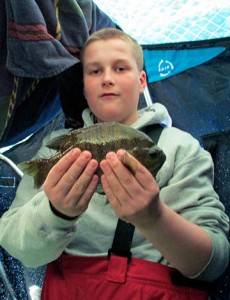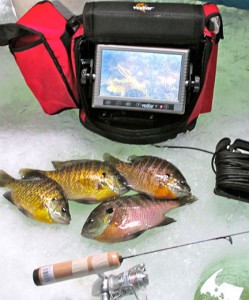By Steve Weisman
Outdoor Editor
What is it about being able to watch a fish bite? To me, it’s the ultimate. To be able to watch the fish approach the lure, to see its response to the presentation and then (hopefully) the resulting strike – or if not, the resulting decline. That is the total package as far as I am concerned.
Yes, I know that flashers will show us fish approaching, fish moving up and down with the lure and when the fish is in the hot zone. Most of the time that is good enough. When the fish hits the hot zone, keeping the same presentation going will often trigger a strike.
HOWEVER, sometimes the strike doesn’t happen. The fish is there in the hot zone and then it slowly slips away. Why? What happened?
That is precisely why I like to be able to “see” what is going on below. When it is a clear water situation, and we’re in the shallows (like on West Okoboji), we can sight fish with our own eyes. Now, when the fish come in, we can see exactly what they are doing and how they respond to our presentation. If enough fish are in the area and enough are attracted to our bait, we begin to see a pattern establish itself. If we pay close attention, we can soon refine our presentation to get a majority of the fish to strike. Mission accomplished!
Yes, the pattern can change, certainly from day to day. Yes, even from hour to hour. So, what do we do when we can’t see down? Well, we can do what we have always done and go by how we think the fish are responding. But how many times have you said this or heard your fishing partner say, “I don’t understand. I can see the fish come flying up on my flasher, and I can get them to follow me up and down, but I can’t get them to bite.”
My answer costs money, say $300-$400, but compared to electronics on a boat, it’s not so bad. I’m talking an underwater camera. I’ve had one for probably 20 years, and they certainly have become more refined and just like using a mini-television to see what’s below the ice.
My current camera is the Vexilar Scout, and the more I use it, the more I appreciate what it does for me. Of course, there are other brands out there that anglers speak highly of. There are different ways to do this, but I like to down-view with the camera instead of viewing from the side. Viewing from the side is another column in itself. I also drill a hole adjacent to the one that I am jigging in to help alleviate chances of getting caught up in the camera cable.
Case in point
Twice I recently fished bluegills in an area where I could see down about 5’, but the depth was 7’, and the fish were tight on the bottom to 1’ off the bottom. Without the camera, I could see the tiny jig, but I could not see the fish. What I saw was an incredible movie, and I was the only one watching.
On the first trip, the bluegills were very finicky, almost lethargic and came through only one at a time. They moved slowly, and approached my bait almost hesitantly. They would come right up to it and stare and stare and stare. If I changed my presentation (a tight jiggle, jiggle, jiggle), they would stop and just hover there…and then they would slowly fin back and away, moving at an extremely slow place.
I found, however, if I continued the same jiggle, and I did not vary it, they would very slowly come…nose to bait…and then inhale it. Sometimes, however, it was only the tip or maybe it was the middle or the head of my tiny jig. So, I had to also adjust to that and set the hook at exactly the RIGHT time. Sometimes, yes, sometimes, no! However, I did take a nice mess of 8-9” gills home with me.
The second day
This was totally different. On this day, it began the same way as the first day. However, after about an hour, everything changed. I used the same bait, the same jiggle. At times, I’d have 5-6 gills come from different directions right toward my jig. Exciting, you bet. However, it also caused troubles. They would sometimes cut each other off at the pass. Sometimes they would even bump into each other in their desire to get to their “food.”
When that happened, it kind of sent a shock wave through the bunch, and they would just sit there, trying to decide whether they should continue toward the bait or not. Sometimes one or more than one would continue on. At other times, they would all move away. Sometimes one single gill would come rushing right toward the bait so hard and fast that they would misjudge their approach and slide right on by. Often, they would swing around and come back. Other times they would just continue on.
Still, the presentation had to be consistent with what brought them into the strike zone. Any change or even stopping would shut them down right now! Over three hours, though, I caught well over 40 gills and kept enough (20) for a good family meal.
You can call me crazy if you want, but I am a true, true believer in sight fishing-by eye or camera. Not only is it fun, but it also works.



















